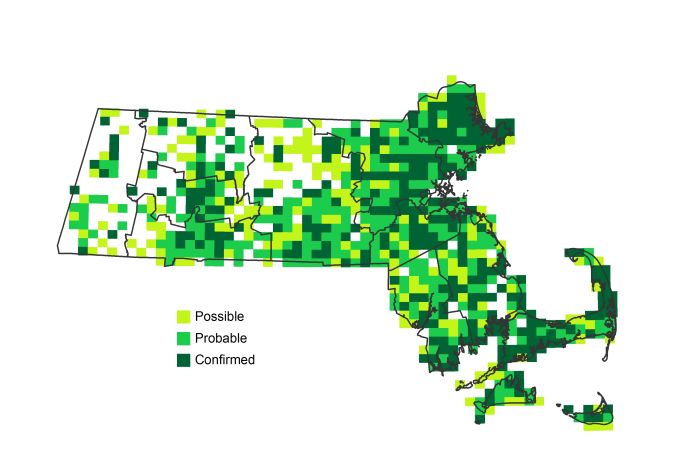Breeding Bird Atlases (BBA)
Find a Bird
Carolina Wren
Thryothorus ludovicianus

Very widespread and strongly increasing

“You cannot fly like an eagle with the wings of a wren.” – William Henry Hudson, Afoot in England
It’s true that the wings of Carolina Wrens are ill-suited for soaring like an eagle. However, they are well-suited for flitting from branch to branch in the tangled undergrowth where the species prefers to forage. Carolina Wrens have historically been found mostly in the moist bottomland forests of the southern US, but they have proven to be remarkably adaptable. Today, the emphatic song of the Carolina Wren is frequently heard in both wilderness thickets and suburban developments throughout Massachusetts, but that has not always been the case.
Historic Status
“The Great Carolina Wrens,” wrote Henry Davis Minot, “so far as I know, have not previously been reported as visitors to Massachusetts, but there are, at present, two apparently passing the summer in a small wooded swamp near Boston.” This was the first definite reference to the species in the state, in the latter part of nineteenth century. “It is further believed that they are now building or have recently built their nest,” (Minot 1877) Minot continued, though that notion was never proved. Carolina Wrens were recorded in Massachusetts only five more times in the next quarter century, but a nest found in 1901 on Naushon Island established their breeding presence in the Commonwealth (Forbush 1929). Throughout the twentieth century, the species moved northward, gradually becoming more common as the century wore on at the northern edge of its breeding range in Massachusetts. It has long been suspected that Carolina Wrens are dependent upon relatively mild winters, and early colonization attempts were allegedly knocked back during unusually cold winters (Veit & Petersen 1993).
Atlas 1 Distribution
The Atlas 1 distribution of Carolina Wrens captured a snapshot of a species in the middle of a northward range expansion. Having slowly colonized different areas of Massachusetts as a breeding species since the dawn of the twentieth century, Carolina Wrens were especially concentrated in the southernmost areas of the state. The lower Connecticut River Valley seemed to be a welcoming route into the Commonwealth for adventurous Carolina Wrens, and there the species occupied a small but notable outpost. It was the Bristol/Narragansett Lowlands that were incubating the Carolina Wren population at that time, with 52% of the species’ statewide range in the welcoming thickets and suburbs of the region. The Cape Cod and the Islands ecoregion hosted 33% of the species’ statewide range, though the wrens had not yet made it as far as Nantucket.
Atlas 2 Distribution and Change
By the time of Breeding Bird Atlas 2, Carolina Wrens had successfully colonized every ecoregion in the state, and the species also posted the third largest overall increase in new blocks occupied. This remarkable expansion, also witnessed in neighboring New York (McGowan & Corwin 2008) and throughout much of the Northeast is thought to be due to the species’ suburban adaptability, combined with the trend toward warming winters (Haggerty & Morton 1995). Carolina Wrens have become fairly widespread in most ecoregions of the state, except for the Taconics, Lower Berkshire Hills, and Berkshire Highlands. The Connecticut River Valley boasts a notable 86% block occupancy, and likely served as a route for expansion into the western regions of the state. The colonization has been most thorough in the eastern portions of the state, where 82 to 92% of the blocks are occupied.
Atlas 1 Map

Atlas 2 Map

Atlas Change Map

Ecoregion Data
Atlas 1 | Atlas 2 | Change | ||||||
Ecoregion | # Blocks | % Blocks | % of Range | # Blocks | % Blocks | % of Range | Change in # Blocks | Change in % Blocks |
Taconic Mountains | 0 | 0.0 | 0.0 | 1 | 4.0 | 0.1 | 1 | 6.7 |
Marble Valleys/Housatonic Valley | 0 | 0.0 | 0.0 | 23 | 59.0 | 3.1 | 23 | 59.0 |
Berkshire Highlands | 0 | 0.0 | 0.0 | 14 | 25.5 | 1.9 | 12 | 22.6 |
Lower Berkshire Hills | 0 | 0.0 | 0.0 | 9 | 29.0 | 1.2 | 8 | 29.6 |
Vermont Piedmont | 0 | 0.0 | 0.0 | 9 | 52.9 | 1.2 | 6 | 50.0 |
Berkshire Transition | 0 | 0.0 | 0.0 | 19 | 47.5 | 2.5 | 15 | 48.4 |
Connecticut River Valley | 3 | 5.4 | 4.5 | 56 | 86.2 | 7.5 | 39 | 81.3 |
Worcester Plateau | 0 | 0.0 | 0.0 | 42 | 47.7 | 5.6 | 26 | 54.2 |
Lower Worcester Plateau | 1 | 1.4 | 1.5 | 49 | 61.3 | 6.5 | 33 | 61.1 |
S. New England Coastal Plains and Hills | 6 | 2.2 | 9.1 | 261 | 92.2 | 34.8 | 208 | 92.0 |
Boston Basin | 0 | 0.0 | 0.0 | 47 | 83.9 | 6.3 | 47 | 85.5 |
Bristol and Narragansett Lowlands | 34 | 32.1 | 51.5 | 102 | 89.5 | 13.6 | 62 | 61.4 |
Cape Cod and Islands | 22 | 16.2 | 33.3 | 119 | 82.6 | 15.8 | 80 | 66.7 |
Statewide Total | 66 | 6.8 | 100.0 | 751 | 72.4 | 100.0 | 560 | 67.6 |
Notes
The Carolina Wren shows significant increasing Breeding Bird Survey trends in Massachusetts, in the New England/Mid-Atlantic Region, and in the Eastern US overall. Neighboring states show similar trends for this species.



